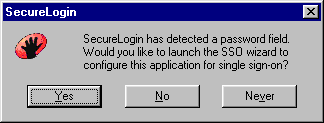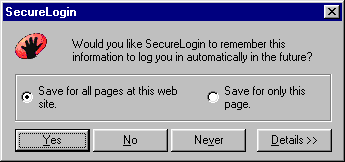After SecureLogin is installed on your desktop, SecureLogin watches for applications that aren't enabled for single sign-on. Upon detecting such an application, SecureLogin prompts you to use a wizard to enable those applications for single sign-on and thereby simplify future logins.
After detecting a Windows login panel, SecureLogin displays the following dialog box. (If the application has a prebuilt script, the initial text varies.)

You can choose not to enable single sign-on for this application. If you select Never, SecureLogin generates a blank script for this application and doesn't prompt you again. If you select No, SecureLogin prompts you the next time that you launch the application.
If you click Yes, SecureLogin launches the Add Applications Wizard, which guides you through the setup and creates a script for the login panel. The next time you open the application, SecureLogin authenticates for you.
When you navigate to a Web page that has a login field and then submit your login information, SecureLogin prompts you whether to enable single sign-on for the site, for only the current page, or not at all.

If you click Yes, SecureLogin extracts the login information from the Web page and stores it for future single sign-on authentication.
When SecureLogin detects a login panel for an application that has a prebuilt script, SecureLogin prompts you with the option to implement that script. The following figure illustrates a prompt for a Web site:

To enable the script, click Yes, then enter the required credentials. SecureLogin logs you into the application whenever the application is launched.
To ignore the prompt, click No. The next time SecureLogin detects the application's login panel, SecureLogin displays this prompt again, unless you create a new script for the application.